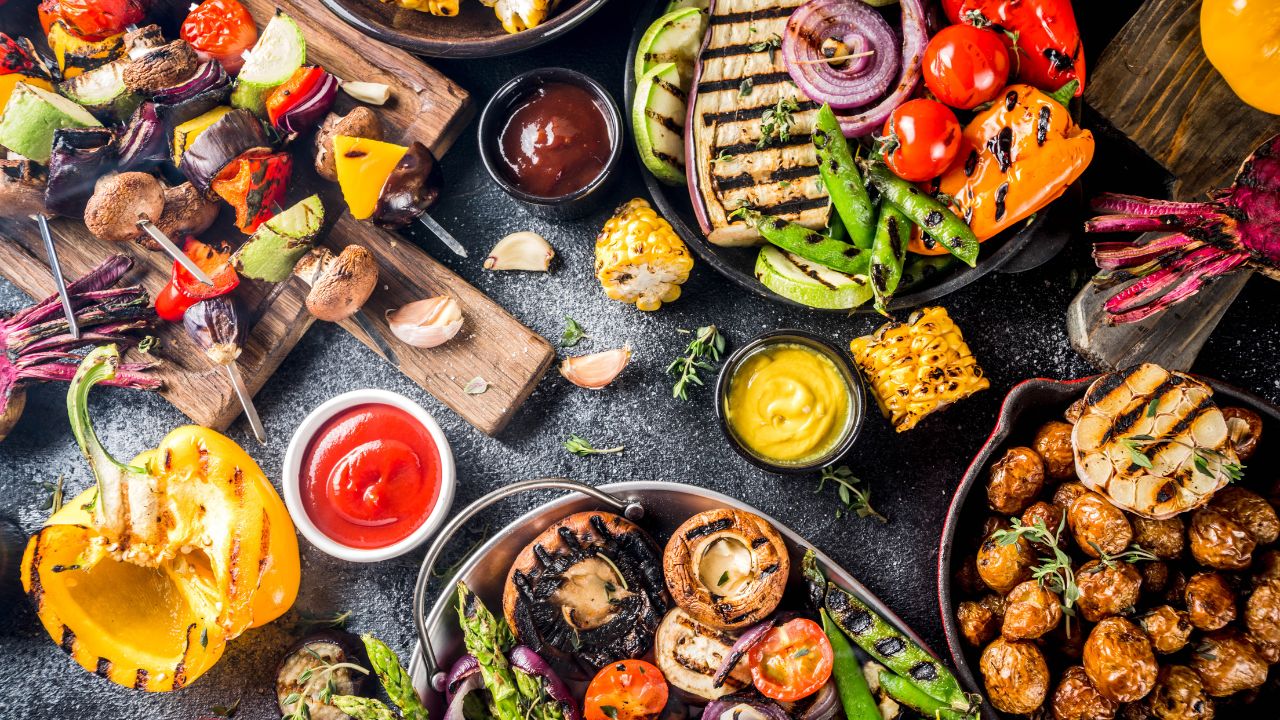In every family, dinner transcends mere food—it’s a cherished time for connection, laughter, and creating lasting memories. However, when your household includes both vegans and those who prefer traditional diets, what should be a joyful gathering can often turn into a complicated juggling act. If you’re navigating the choppy waters of a mixed-diet family, you understand the challenge well: How do you cater to both the plant-based eaters and the non-vegans under one roof without preparing entirely separate meals? That’s where the magic of theme nights comes in!
Making Mealtime Magic for Everyone
At my table, Theme Nights are more than just fun—they are a delicious and stress-free solution that keeps everyone eagerly anticipating dinner. These nights aren’t just entertaining; they’re a strategic, thoughtful way to approach meal planning. Theme nights add an element of excitement to your family dinners, ensuring everyone feels included and catered to. Whether your family is fully committed to vegan living or you’re simply exploring plant-based options, theme nights offer a flexible framework that effortlessly accommodates dishes appealing to both vegans and non-vegans.
This method not only simplifies meal planning but also inspires creativity. With a specific theme in mind, it’s easier to think outside the box, adapting dishes to meet various dietary preferences without the meal feeling disjointed. Let’s dive into how you can implement theme nights that keep everyone at the table happy, nourished, and connected.
The Benefits of Theme Nights
In households where dietary preferences vary, the question of what to cook for dinner can loom large each evening. Theme nights offer a wonderful solution, transforming meal planning from a daunting task into an exciting activity that everyone can look forward to. Here’s how adopting theme nights can significantly benefit your family dinners:
Simplifies Decision Making
Choosing what to cook every night can be tiresome, especially when you’re trying to satisfy multiple dietary needs. Theme nights reduce this decision fatigue by narrowing down the options. For example, if it’s “Italian Night,” you know you’ll be looking at pasta, risotto, or pizza, each of which can be easily adapted for vegan and non-vegan eaters. This not only makes shopping easier but also simplifies meal preparation.
Encourages Creativity and Variety
Having a specific theme in place sparks creativity in the kitchen. It encourages you to explore new recipes and ingredients, keeping mealtime exciting and educational. Themes can rotate between different cuisines and cooking styles, ensuring that meals are never monotonous. This variety is especially important in a mixed-diet household, as it keeps everyone engaged and looking forward to mealtime.
Fosters Inclusivity at the Dinner Table
One of the most significant challenges in families with different eating habits is making sure everyone feels included. Theme nights address this by allowing for variations on the same base meal. For instance, a taco night can offer different fillings like seasoned beans, mushrooms, and peppers for vegans, alongside traditional meats for non-vegans. Everyone shares the same basic meal structure but can customize according to their dietary preferences, promoting a sense of unity rather than division.
Enhances the Mealtime Experience
Theme nights are not just about the food; they’re about the experience. They can be educational (exploring different cultures through cuisine), nostalgic (recreating dishes from a favorite vacation), or simply fun (a movie night with themed snacks). This turns dinner into more than just eating; it becomes a shared adventure that everyone can contribute to and enjoy, making mealtime a highlight of the day.
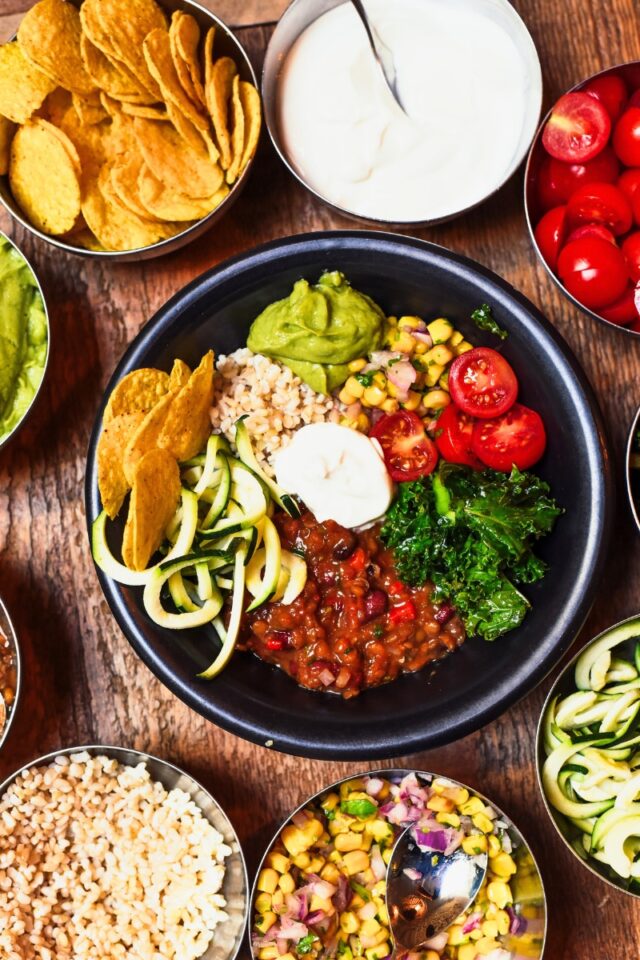
Choosing Your Themes
Deciding on the theme for each night can be as enjoyable as the meal itself! The key is to pick themes that offer flexibility and can accommodate various dietary preferences seamlessly. Here are some tips on selecting themes and some examples to get you started:
Tips for Selecting Themes
1. Focus on Versatility: Choose themes that naturally lend themselves to both vegan and non-vegan adaptations. For example, many international cuisines, like Mexican or Mediterranean, feature a wide array of plant-based ingredients that can be easily paired with or substituted for animal products.
2. Consider All Preferences: Ensure the themes are appealing to all family members. It might be helpful to have a family meeting to discuss everyone’s favorite foods and cuisines and then rotate who gets to pick the theme each week.
3. Keep It Simple: While it’s fun to be adventurous, it’s also important to keep practicality in mind. Choose themes that won’t require overly complex cooking methods or hard-to-find ingredients, especially on busier nights.
4. Engage Everyone in the Planning: Involve the whole family in choosing themes not only ensures that the meals meet everyone’s dietary preferences but also builds anticipation and excitement for dinner times. It turns meal planning into a collaborative and fun activity that everyone looks forward to, reinforcing the joy and connection that comes from shared meals.
Theme Ideas to Get You Started
1. Global Taste Tour: Rotate through different countries’ cuisines each week. Mexican, Italian, Indian, Thai, and Japanese are particularly great for accommodating diverse diets with minimal adjustments needed.
2. Historical Eras: This can be a fun educational theme, such as Ancient Roman night or Medieval feast, where you can explore different historical diets and adapt them to modern tastes and dietary needs.
3. Ingredient Spotlight: Pick a versatile ingredient and use it in various dishes. For instance, a “Tomato Night” might feature tomato soup, a fresh tomato salad, and hearty shakshuka with options to add eggs for non-vegans.
4. Color Themes: Have a little fun with colors—like an “Orange Night” with dishes featuring carrots, oranges, and sweet potatoes. This can be a playful way to encourage kids to eat more fruits and vegetables.
5. DIY Stations: Set up stations where everyone can make their versions of the dish. Pizza night, for example, can have different crusts, including gluten-free, and an array of toppings ranging from vegan cheeses to various meats.
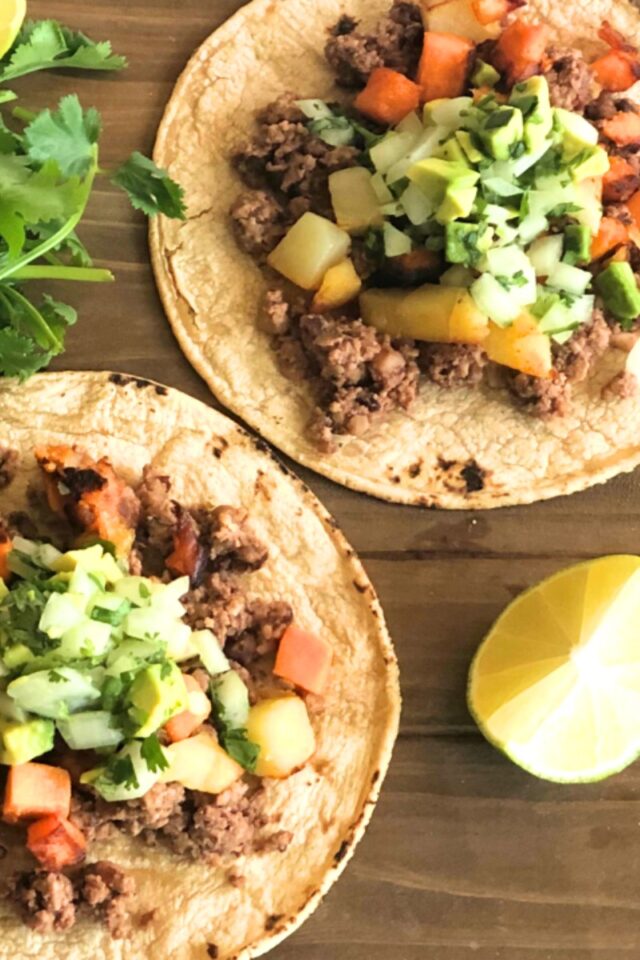
Theme Night Ideas and How to Adapt Them
Having a variety of theme nights ensures that everyone at the dinner table is excited about mealtime. Here are some themed ideas that are adaptable and sure to please both vegans and non-vegans alike:
1. Mexican Fiesta
Vegan and Non-Vegan Options:
- Tacos: Prepare fillings like sautéed vegetables, spiced lentils, or a walnut-bean chorizo alongside traditional beef or chicken. Offer a variety of toppings such as guacamole, salsa, vegan sour cream, and cheese, alongside regular dairy products.
- Sides: Include vegan refried beans, rice cooked in vegetable broth, and a big basket of chips.
Tips:
- Utilize taco seasoning liberally across both vegan and non-vegan fillings to unify the flavors.
- Have a mix of soft and hard taco shells to cater to personal preferences.
2. Italian Pasta Night
Vegan and Non-Vegan Options:
- Sauces: Offer a selection including marinara, vegan creamy pesto, and a traditional meat sauce.
- Pastas: Provide both regular and gluten-free options to cater to different dietary needs.
- Sides: Serve with a big green salad and crusty Italian bread for soaking up the sauce. Regular and vegan Italian sausages are also a great choice to serve with pasta.
Tips:
- Pasta salads can be a great meal idea option, especially if you prepare a vegan base salad and offer assorted mix-ins including proteins.
- Consider making a DIY pasta bar where family members can pick their pasta, sauce, and toppings.
3. Burger Bar
Vegan and Non-Vegan Options:
- Patties: Offer a selection of vegan patties made from beans, lentils, or commercial vegan options, along with traditional beef patties.
- Toppings and Condiments: Set out a variety of toppings like lettuce, tomatoes, onions, vegan and non-vegan cheeses, ketchup, mustard, and vegan mayo.
- Sides: There are lots of options here, but the obvious is fries! A green salad or slaw is a healthy veg choice.
Tips:
- Encourage experimentation with different combinations of toppings and patties.
- Toasting the buns adds an extra touch of flavor that enhances the burger experience for everyone.
- Assign a theme to your burger bar, such as Italian, Latin or BBQ.

4. Asian Stir-Fry
Vegan and Non-Vegan Options:
- Base: Start with a mix of stir-fried vegetables and provide options like tofu for vegans and chicken or shrimp for non-vegans.
- Sauces: Ensure sauces like soy, hoisin (check for fish ingredients in non-vegan versions), and sweet chili are available to suit different tastes.
- Sides: Store-bought frozen dumplings or potstickers are a favorite in my house.
Tips:
- Use rice or noodles as a base to bulk up the meal.
- Cooking the protein options separately and serving them buffet style allows each family member to customize their plate.
5. Breakfast for Dinner
Vegan and Non-Vegan Options:
- Main Dishes: Offer vegan pancakes or waffles alongside traditional ones. Include scrambled tofu for vegans and scrambled eggs for non-vegans.
- Sides: Serve a variety of toppings and sides such as maple syrup, fresh fruits, vegan butter, bacon, and vegan sausages.
Tips:
- This idea is particularly engaging for families with children, giving them the joy of customizing their meal.
- Prep the waffles or pancakes in advance and either freeze or store in airtight containers to speed up dinner prep during the week.
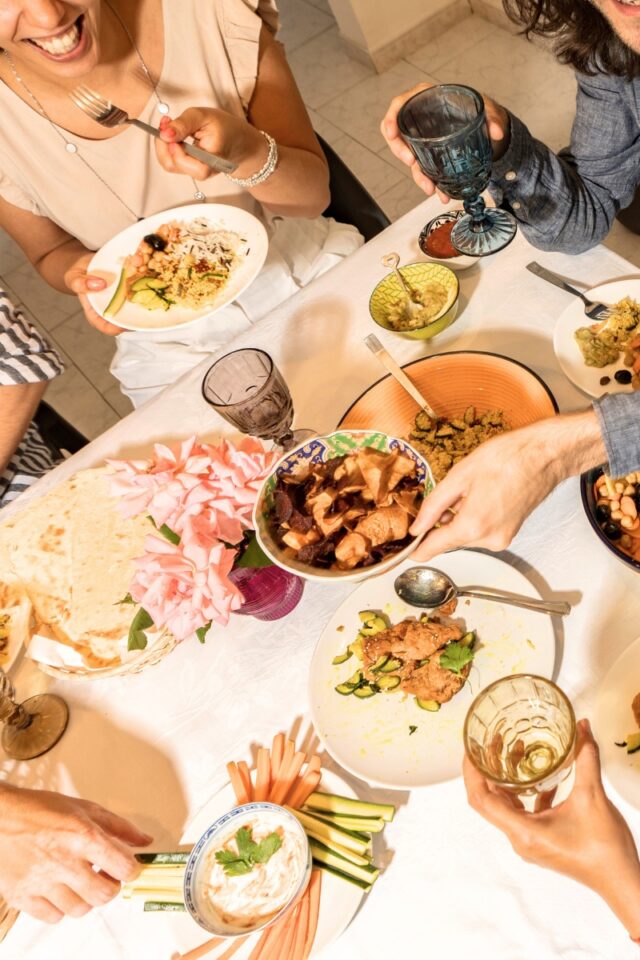
Practical Tips for Implementing Theme Nights
Introducing theme nights into your family meal routine should be a fun and stress-free experience. To ensure this transition is as smooth as possible and that everyone at the table enjoys these theme nights, here are some practical tips to keep in mind:
Plan Ahead
Organization is Key:
- Dedicate some time each week to plan out the theme nights (ideally when you’re compiling your complete dinner plan for the week). This not only saves you last-minute stress but also allows you to shop for ingredients in advance, ensuring you have everything you need.
- Create a meal plan template that outlines your theme nights. Visibility of what’s coming up can help build excitement and anticipation among family members.
Keep Everyone Involved
Inclusivity Enhances Engagement:
- Allow each family member to choose a theme for one night. This gives them something to look forward to and ensures that each person’s preferences are considered.
- Encourage family members to help with the meal preparation. This could be as simple as chopping vegetables, setting the table, or helping to stir a pot. Engagement in the process makes the meal more rewarding.
Be Flexible
Adaptability is Crucial:
- While it’s great to have a plan, sometimes things don’t go as expected. Be prepared to swap theme nights around based on your family’s schedule or mood.
- Have some quick and easy backup options available that still fit within the theme but reduce preparation time on particularly busy evenings.
Educate and Experiment
Learning and Discovery:
- Use theme nights as an opportunity to teach your children about different cultures, ingredients, and cooking techniques. This educational aspect can make each meal more meaningful.
- Don’t be afraid to try new recipes or tweak traditional ones to fit your family’s dietary needs. Experimentation can lead to new favorite dishes and expand your culinary repertoire.
Create Atmosphere
Set the Scene:
- Enhance the theme night experience by decorating the dining area according to the theme or playing music that matches the cuisine or era you are exploring.
- Small touches like themed napkins, plates, or even costumes can make the evening more immersive and enjoyable for everyone.
Reflect and Adjust
Feedback is Valuable:
- After each theme night, take a moment to discuss what everyone liked or didn’t like about the meal. This feedback is invaluable for planning future meals that are even more successful.
- Keep track of the most popular themes and dishes, and consider revisiting them with slight variations to keep things interesting.
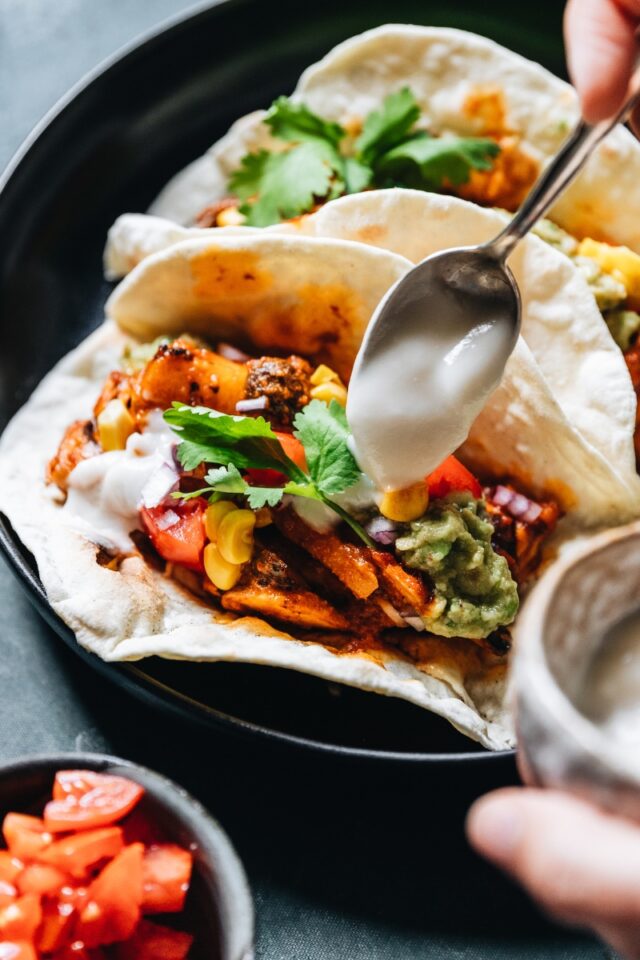
Bringing Joy and Connection to the Dinner Table
Incorporating theme nights into your weekly meal planning is more than just a way to address the diverse dietary needs of your family; it’s a chance to transform dinner into a delightful experience that everyone can look forward to. By embracing this approach, you’re not only simplifying meal preparation but also creating opportunities for connection, education, and fun.
Theme nights invite creativity and exploration into your kitchen and dining room, turning them into places of discovery and enjoyment. Whether you’re traveling through the flavors of the world on a “Global Taste Tour,” enjoying the whimsy of a “Color Theme” night, or sharing laughs over a “Breakfast for Dinner” spread, these themed meals can enhance family bonds and ensure that everyone feels included and catered to, no matter their dietary preferences.
As you move forward with theme nights, remember that the ultimate goal is to foster a sense of joy, connection, and love around your family’s dinner table. With each themed meal, you’re not just filling plates—you’re building memories. So, gather your loved ones, set your themes, and let the culinary adventures begin, ensuring that each dinner is not just eaten but truly savored.

